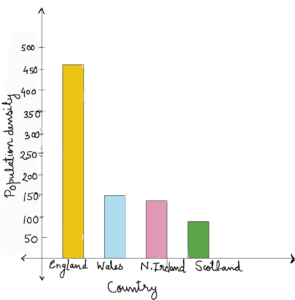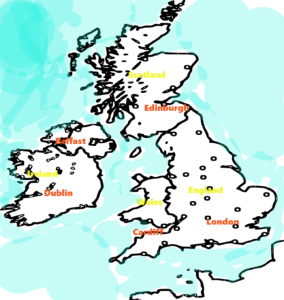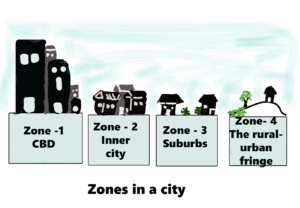Most of the cities that can be found in the UK are incredibly unique. This is because they are located where they are for a geography-related reason. For your geography examination, you will need to be able to spot why cities are located where they are and how the people benefit from that.
Our Cities
If you take a look at a map of the United Kingdom, then you should be able to see that a lot of the cities are based in very specific areas. These are usually lowland areas that are close to natural resources. Over the years, a lot of towns have merged to create large areas that feature high population densities.
Most of the cities can be found in the following zones:
Areas of Mineral Wealth
A lot of cities can be found around areas of mineral wealth. This has led to major population growth where coal and iron industries have developed in the past, but that has since created some problems. When you look at all of the coalfields that are in the UK, you can see that cities like Leeds have been built on top of them.
Lowland Areas
Most of the cities in the United Kingdom have been developed in lowland areas. This is because a lot of lowland areas are really easy to build on and they tend to feature relatively mild climates.
Upland Areas
Upland areas are the literal opposite of lowland areas in several different ways. For example, they tend to be sparsely populated. People haven’t been as attracted to them because it is quite difficult to use the land in upland areas for agricultural purposes and there aren’t many natural resources.
Coastal Areas
Coastal areas in the United Kingdom have attracted settlers for a few different reasons, including their natural beauty. A lot of people have chosen to settle there in the past, but more densely populated areas are usually near sheltered bays and river estuaries, because they are suitable for harbours. This has led to some of our key ports being housed in major cities.
You should also note that London is the biggest city in the United Kingdom. It is home to more than 8 million people, meaning that approximately 10% of the total population can be found there.
Inner City Zones
Now that you know where most of our cities can be found on the map, you need to know what they consist of. A lot of the cities in the United Kingdom are home to unique zones, these are distinct areas. As part of your geography examination, you will more than likely be asked to spot some of them on a map.
They include:
Zone One: The Central Business District (CBD)
It is really easy to spot the Central Business District on maps because it can usually be found right in the middle of a town or city. It is normally home to lots of public buildings, some of which can be seen on a map. These include train stations, hotels and different types of entertainment facilities. Sometimes, the CBD is also surrounded by a ring road.
Zone Two: The Inner City Zone
The inner city zone can usually be found in the centre of a city and it features a distinctive mix of different land uses, including both residential properties and commercial properties. You can usually spot everything from old terraced houses to modern tower blocks. During your exam, you should look for areas of the map that show parallel roads. These usually point to residential housing in the inner city.
Zone Three: The Suburbs
Spotting the suburbs on a map is usually really easy to do. They lie around the inner city zone and they feature properties that are mainly residential. These tend to include a lot of semi-detached houses. Try to look for curved streets and cul-de-sacs if you are asked to spot the suburbs on a map, as they are the opposite of the parallel streets that you would see in the inner city zone.
Zone Four: The Rural-Urban Fringe
The rural-urban fringe is a unique area and it will probably be the easiest of the four for you to spot on a map during your exam. It can be found around the very edge of a city and it usually features areas of farmland and open spaces that are mixed in with new housing developments.
Whether or not housing developments should be built on the rural-urban fringe is up for debate. A lot of them are being built on rural greenfield land, which is land that has not been previously built on. This can create a nice place for people to live, but it also results in the loss of open spaces and entire ecosystems.
The Changing World of UK Cities
The ways in which cities are changing in the United Kingdom creates a lot of different opportunities and problems. These include:
Opportunities
- Cities in the United Kingdom suffer from massive congestion problems, especially around rush hour. This is mostly because of the number of commuters who need to go to the Central Business District (CBD) for work. Luckily, this has led to planners coming up with some innovative transport solutions to handle the problem.
- Planners are also aware of the fact that so many people have to spend their time in the Central Business District. This has led to more offices being developed and more entertainment facilities popping up, creating more employment opportunities in the CBD.
- Cities in the United Kingdom are currently undergoing a lot of redevelopment. This presents a lot of investment opportunities and has led to a lot of entertainment venues being upgraded.
- A lot of the cities in the United Kingdom are multicultural. This is because of immigrant communities who were attracted by the affordable cost of inner city housing. This has led to a lot of unique restaurants and festivals popping up.
- As cities are being redeveloped, planners are acknowledging the fact that open spaces are important. This has led to a lot of areas being regenerated.
Problems
- If you walk around a city, then you will probably notice that there is a lot of derelict land. These areas are called brownfield sites and they can be used to develop new residential and commercial properties. Unfortunately, a lot of new estates are being built on rural greenfield sites instead. Greenfield sites are now home to a lot of business parks because they have decent transport links and the cost of purchasing a business venue is more affordable than it would be in the inner cities.
- There are a lot of deprived areas in cities in the UK. The people who live there usually struggle to access decent health care and there are fewer job opportunities in these areas. This leads to a lot of social unrest.
- Due to industrial decline in the United Kingdom, a lot of the wealth that was once there has now been lost. This has led to people moving away, leaving more derelict buildings behind.
Frequently Asked Questions
What are some of the key historical factors that have shaped the growth and development of cities in the UK?
Factors include industrialization, urbanization, colonial history, and post-World War II rebuilding efforts.
Describe the unique characteristics and cultural diversity of cities like London, Manchester, and Edinburgh.
London is the capital and a global financial hub. Manchester has a rich industrial heritage, and Edinburgh is known for its historic architecture and festivals.
How do cities in the UK address urban planning, transportation, and sustainability challenges in the 21st century?
Cities prioritize public transport, sustainable development, green spaces, and initiatives to reduce congestion and air pollution.
What role do historic landmarks and cultural institutions play in the identity and tourism of UK cities?
Historic landmarks, such as the Tower of London, and cultural institutions, like the British Museum, attract tourists and contribute to the cultural fabric of cities.
How have cities in the UK adapted to economic changes, such as the shift from manufacturing to services and technology industries?
Cities have diversified their economies, focusing on finance, tech, education, and creative industries to adapt to changing economic landscapes.








